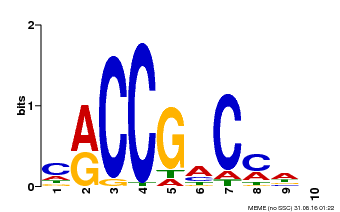- Riechmann JL, et al.
Arabidopsis transcription factors: genome-wide comparative analysis among eukaryotes.
Science, 2000. 290(5499): p. 2105-10
[PMID:11118137] - P
New molecular phenotypes in the dst mutants of Arabidopsis revealed by DNA microarray analysis.
Plant Cell, 2001. 13(12): p. 2703-17
[PMID:11752382] - Ekman DR,Lorenz WW,Przybyla AE,Wolfe NL,Dean JF
SAGE analysis of transcriptome responses in Arabidopsis roots exposed to 2,4,6-trinitrotoluene.
Plant Physiol., 2003. 133(3): p. 1397-406
[PMID:14551330] - Dal Bosco C, et al.
Inactivation of the chloroplast ATP synthase gamma subunit results in high non-photochemical fluorescence quenching and altered nuclear gene expression in Arabidopsis thaliana.
J. Biol. Chem., 2004. 279(2): p. 1060-9
[PMID:14576160] - Yamada K, et al.
Empirical analysis of transcriptional activity in the Arabidopsis genome.
Science, 2003. 302(5646): p. 842-6
[PMID:14593172] - Gepstein S, et al.
Large-scale identification of leaf senescence-associated genes.
Plant J., 2003. 36(5): p. 629-42
[PMID:14617064] - Kasukabe Y, et al.
Overexpression of spermidine synthase enhances tolerance to multiple environmental stresses and up-regulates the expression of various stress-regulated genes in transgenic Arabidopsis thaliana.
Plant Cell Physiol., 2004. 45(6): p. 712-22
[PMID:15215506] - Souret FF,Kastenmayer JP,Green PJ
AtXRN4 degrades mRNA in Arabidopsis and its substrates include selected miRNA targets.
Mol. Cell, 2004. 15(2): p. 173-83
[PMID:15260969] - Iwase A,Ishii H,Aoyagi H,Ohme-Takagi M,Tanaka H
Comparative analyses of the gene expression profiles of Arabidopsis intact plant and cultured cells.
Biotechnol. Lett., 2005. 27(15): p. 1097-103
[PMID:16132859] - Kim S,Soltis PS,Wall K,Soltis DE
Phylogeny and domain evolution in the APETALA2-like gene family.
Mol. Biol. Evol., 2006. 23(1): p. 107-20
[PMID:16151182] - McGrath KC, et al.
Repressor- and activator-type ethylene response factors functioning in jasmonate signaling and disease resistance identified via a genome-wide screen of Arabidopsis transcription factor gene expression.
Plant Physiol., 2005. 139(2): p. 949-59
[PMID:16183832] - Nakano T,Suzuki K,Fujimura T,Shinshi H
Genome-wide analysis of the ERF gene family in Arabidopsis and rice.
Plant Physiol., 2006. 140(2): p. 411-32
[PMID:16407444] - Pischke MS,Huttlin EL,Hegeman AD,Sussman MR
A transcriptome-based characterization of habituation in plant tissue culture.
Plant Physiol., 2006. 140(4): p. 1255-78
[PMID:16489130] - Xiong Y,Fei SZ
Functional and phylogenetic analysis of a DREB/CBF-like gene in perennial ryegrass (Lolium perenne L.).
Planta, 2006. 224(4): p. 878-88
[PMID:16614820] - Pati A,Vasquez-Robinet C,Heath LS,Grene R,Murali TM
XcisClique: analysis of regulatory bicliques.
BMC Bioinformatics, 2006. 7: p. 218
[PMID:16630346] - Jung J, et al.
The barley ERF-type transcription factor HvRAF confers enhanced pathogen resistance and salt tolerance in Arabidopsis.
Planta, 2007. 225(3): p. 575-88
[PMID:16937017] - Catala R, et al.
The Arabidopsis E3 SUMO ligase SIZ1 regulates plant growth and drought responses.
Plant Cell, 2007. 19(9): p. 2952-66
[PMID:17905899] - Shaikhali J, et al.
The redox-sensitive transcription factor Rap2.4a controls nuclear expression of 2-Cys peroxiredoxin A and other chloroplast antioxidant enzymes.
BMC Plant Biol., 2008. 8: p. 48
[PMID:18439303] - Welling A,Palva ET
Involvement of CBF transcription factors in winter hardiness in birch.
Plant Physiol., 2008. 147(3): p. 1199-211
[PMID:18467468] - Kim JM, et al.
Alterations of lysine modifications on the histone H3 N-tail under drought stress conditions in Arabidopsis thaliana.
Plant Cell Physiol., 2008. 49(10): p. 1580-8
[PMID:18779215] - Weber H,Hellmann H
Arabidopsis thaliana BTB/ POZ-MATH proteins interact with members of the ERF/AP2 transcription factor family.
FEBS J., 2009. 276(22): p. 6624-35
[PMID:19843165] - Lin RC,Park HJ,Wang HY
Role of Arabidopsis RAP2.4 in regulating light- and ethylene-mediated developmental processes and drought stress tolerance.
Mol Plant, 2008. 1(1): p. 42-57
[PMID:20031913] - Xu H,Wang X,Chen J
Overexpression of the Rap2.4f transcriptional factor in Arabidopsis promotes leaf senescence.
Sci China Life Sci, 2010. 53(10): p. 1221-6
[PMID:20953945] - Iwase A, et al.
The AP2/ERF transcription factor WIND1 controls cell dedifferentiation in Arabidopsis.
Curr. Biol., 2011. 21(6): p. 508-14
[PMID:21396822] - Rae L,Lao NT,Kavanagh TA
Regulation of multiple aquaporin genes in Arabidopsis by a pair of recently duplicated DREB transcription factors.
Planta, 2011. 234(3): p. 429-44
[PMID:21509693] - Iwase A,Ohme-Takagi M,Sugimoto K
WIND1: a key molecular switch for plant cell dedifferentiation.
Plant Signal Behav, 2011. 6(12): p. 1943-5
[PMID:22112447] - Ding Y, et al.
Four distinct types of dehydration stress memory genes in Arabidopsis thaliana.
BMC Plant Biol., 2013. 13: p. 229
[PMID:24377444] - Iwase A, et al.
Arabidopsis WIND1 induces callus formation in rapeseed, tomato, and tobacco.
Plant Signal Behav, 2013. 8(12): p. e27432
[PMID:24389814] - Hiltscher H, et al.
The radical induced cell death protein 1 (RCD1) supports transcriptional activation of genes for chloroplast antioxidant enzymes.
Front Plant Sci, 2014. 5: p. 475
[PMID:25295044] - Iwase A, et al.
WIND1-based acquisition of regeneration competency in Arabidopsis and rapeseed.
J. Plant Res., 2015. 128(3): p. 389-97
[PMID:25810222] - Ikeuchi M, et al.
PRC2 represses dedifferentiation of mature somatic cells in Arabidopsis.
Nat Plants, 2015. 1: p. 15089
[PMID:27250255] - Iwase A, et al.
WIND1 Promotes Shoot Regeneration through Transcriptional Activation of ENHANCER OF SHOOT REGENERATION1 in Arabidopsis.
Plant Cell, 2017. 29(1): p. 54-69
[PMID:28011694] - Okamuro JK,Caster B,Villarroel R,Van Montagu M,Jofuku KD
The AP2 domain of APETALA2 defines a large new family of DNA binding proteins in Arabidopsis.
Proc. Natl. Acad. Sci. U.S.A., 1997. 94(13): p. 7076-81
[PMID:9192694]
|





